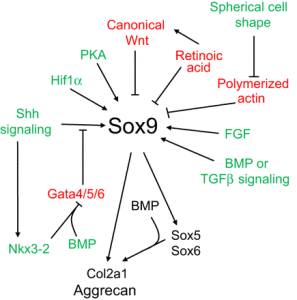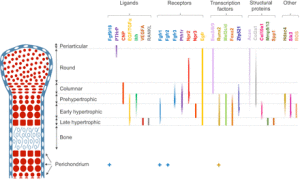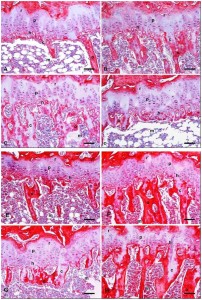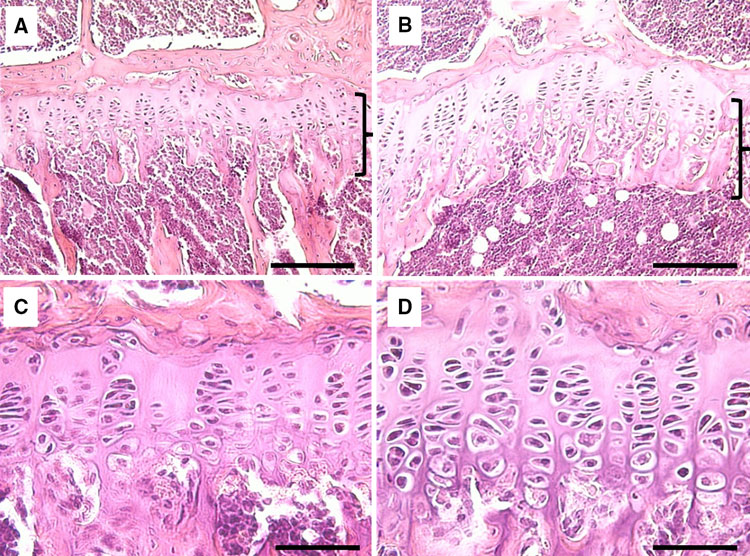Sclerosteosis is characterized by tall stature. If we understand why this occurs we can mimic it and possibly apply it to ourserves to become taller. Sclerosteosis is typified by very low levels of sclerostin in serum. If we also inhibit sclerostin we may be able to obtain the tall stature of those with this syndrome.
There are anti-sclerostin inhibitors that are at Stage II and III of clinical trials. Since Sclerostin is produced by osteocytes and affects bone formation by osteoblasts it’s possible that it could have an impact on bone growth outside of the growth plate. Although Wnt signaling, which Sclerostin inhibits also affects cartilage growth.
Sclerostin inhibition has been discussed before.
The sclerostin story: From human genetics to the development of novel anabolic treatment for osteoporosis.
“Sclerosteosis and Van Buchem disease are two rare bone sclerosing disorders characterized by increased bone mineral density, tall stature and entrapment of cranial nerves due to overgrowth of a highly dense bone. Recent advances in human genetics have revealed the genetic background of these disorders by cloning the SOST gene, which is localized on chromosome region 17q12-q21 and codes for sclerostin. Sclerostin is a protein produced almost exclusively from osteocytes inhibiting bone formation by both osteoblasts and osteocytes. At the molecular level, sclerostin inhibits the Wnt signaling pathway, which plays a critical role in osteoblast development and function. Induced sclerostin deficiency in mice reproduces the bone sclerosing human diseases{so inhibiting sclerostin may increase height}, while sclerostin excess leads to bone loss and reduced bone strength. The extracellular nature of sclerostin has rendered it a promising target for the development of novel anti-osteoporotic treatment. Otherwise healthy carriers of the SOST mutation present with increased bone mass and low levels of sclerostin in serum in contrast to patients with sclerosteosis, who exhibit undetectable levels, thus pointing to the possibility of titration of sclerostin levels in the circulation. Based on these unique characteristics, human anti-sclerostin antibodies have been developed and tested in ovariectomized rats and monkeys, demonstrating very promising results in bone formation. Clinical phase II and III trials are currently underway thereby translating human genetics to drug development.”
“[Sclerostin deficiency can cause] overgrowth of skull bones, mandible, ribs, clavicles, long bones and pelvis. Patients are usually tall and have a characteristic face because of the facial deformities of bossing of the forehead and enlargement of the mandible.” <-There are also other problems generated but perhaps we can just lower Sclerostin levels to a certain point so they don’t get too low as to cause issues. Although it seems only those with undetectable levels of Sclerostin have tall stature.
“Circulating sclerostin binds to the LRP5/6/4 proteins preventing the intracellular part of LRP5 from restraining Axin and free beta-catenin from the intracellular protein complex, this leading to its phosphorylation and degradation and consequently inhibition of Wnt signaling.”
“parathyroid hormone inhibits the expression of the SOST gene by osteocytes”
“Calcitonin, on the other hand, which inhibits osteoclast resorption, up-regulates sclerostin expression by osteocytes, while it decreases other osteocyte products such as MEPE and DMP.”
“Mechanical stimulation of the skeleton either through exercise or experimental loading induces bone formation, while immobilization increases the number of sclerostin positive osteocytes”
Romosozumab(A sclerostin inhibitor) is on Stage 3 clinical trials.
But it seems you need virtually total knockout of function of Sclerostin to gain the tall stature. I couldn’t find any studies on adult individuals to see if Sclerostin could increase height post cessation of growth.
According to the study Effect of sclerostin antibody treatment in a mouse model of severe osteogenesis imperfecta., a sclerostin antibody had no effect on bone length in 20 week old adult rats(and also in 4 week old mice). However, with an antibody elimination of sclerostin isn’t likely to be total. In 4 week old mice there was a .3mm(about 2%) increase in bone length between the Sost-Ab and control group that was found to be nonsignificant but this could indicate that further studies could find that Sost-Ab can increase growth in the growing phase. In the 20 week old mice there was no difference between limb lengths in control and Sost-Ab group but it’s possible that the difference could be too small to detect.
Sclerostin antibody treatment causes greater alveolar crest height and bone mass in an ovariectomized rat model of localized periodontitis
“Sixty female, 4-month-old Sprague-Dawley rats{4 month old rats have fairly senescent growth plates} underwent sham operation or bilateral OVX and were left untreated for 2 months. Experimental periodontitis (ligature) was established by placing silk sutures subgingival to the right maxillary first and second molar teeth for 4 weeks, and feeding the rats food and high-sugar drinking water during this period. Thereafter, ligatures were removed and 25mg/kg vehicle or Scl-Ab was administered subcutaneously twice weekly for 6 weeks. Rats were randomized into four groups: (1) Control (Sham+Vehicle), (2) Sham+Ligature+Vehicle, (3) OVX+Ligature+Vehicle, and (4) OVX + Ligature + Scl-Ab. Terminal blood and right maxilla specimens were collected for analyses.
Group 3 rats showed lower bone volume fraction (BVF) of alveolar bone with higher bone resorption and lower bone formation than Group 2 rats. Group 4 rats had higher alveolar crest height, as assessed by linear distance of cementoenamel junction to the alveolar bone crest and greater alveolar bone mass using Micro CT, than Group 3 rats. Significantly higher values of mineral apposition rate (MAR) and mineralizing surface/bone surface (MS/BS) were also observed in Group 4 rats by analyzing polychrome sequential labeling data. Increased serum osteocalcin and osteoprotegerin, and deceased serum tartrate-resistant acid phosphatase and CTx-1 illustrate the ability of Scl-Ab to increase alveolar bone mass by enhancing bone formation and decreasing bone resorption in an animal model of estrogen deficiency osteopenia plus periodontitis.
Scl-Ab could be a potential bone anabolic agent for improving alveolar crest height and higher alveolar bone mass in conditions where alveolar bone loss in periodontitis is compounded by estrogen deficiency osteopenia.”
Note need to analyze full study at some point. Alveolar bone is the bone around the teeth.
This paper describes growth of the mandible. Description of alveolar growth: “The bone of
the mandible begins to grow on each side of the tooth germ. By this growth the
tooth germs come to be in a trough or groove of bone, which also includes the
alveolar nerves and blood vessels”
“with the loss of the teeth the alveolar process is absorbed”






